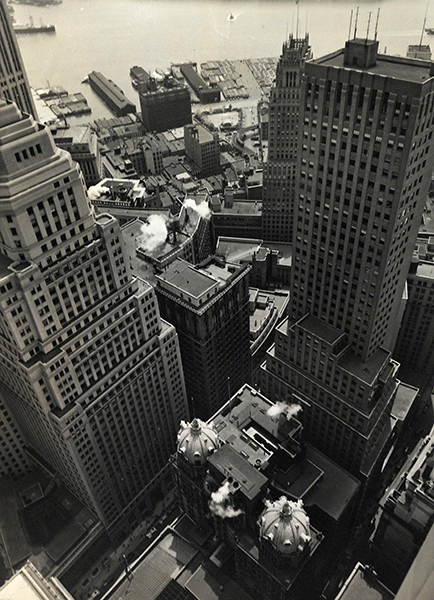Pride Month 2021 II: Berenice Abbott
By the time of the severe world economic downturn of the Great Depression (1929–1940) in America, many women artists were professional photographers and extremely successful in the field of photojournalism. Between 1935 and 1939, Berenice Abbott documented the rapidly changing face of New York in 307 photographs. The series was collected in a portfolio for the 1939 New York World’s Fair entitled Changing New York. Even during the Depression, New York’s ever-growing skyline was a source of national pride.
 |
| Berenice Abbott (1898–1991, U.S.), Water Front from the Roof of the Irving Trust Company Building, 1938. Gelatin silver print on paper, 10" x 8 3/16”” (25.4 x 20.8 cm). Photo © 2021 Brooklyn Museum. Image in the public domain. (BMA-1330) |
In 1935, right around the time Abbott received the commission for Changing New York, she moved with her partner, the noted art critic Elizabeth McCausland (1899–1965), into an apartment at 50 Commerce Street, where they lived until McCausland died in 1965. The Berenice Abbott and Elizabeth McCausland Residence and Studio is part of the New York City LGBTQ Historic Sites Project.
Abbott settled in New York in 1929, where she spent most of her productive life as a photographer. During the Depression, Abbott worked for the Federal Art Project, a Works Progress Administration (WPA) program meant to engage unemployed artists. Abbott created the Changing New York series through funding from the Federal Art Project and the Museum of the City of New York. McCausland also worked for the WPA and wrote the text for the portfolio.
By the 1920s in the United States, the New Vision style in photography had attracted most major American photographers. The majority of those photographers accepted the style’s philosophy that the absolute objectivity of the camera was its best asset, and a unique property of photographic art. Whether depicting nature or architecture, these artists emphasized the material properties of the real world, while stressing modern design. One influence on the New Objectivity, as it was also called, was the fact that photography had become an integral part of advertising, and photographers worked in a modern aesthetic in an effort to reflect the modern industrial world.
Although Abbott’s work was influenced by the New Vision’s emphasis on total objectivity, it also reflects the impact of her art training in Paris and Berlin during the 1920s. Born in Springfield, Ohio, she began studying painting and sculpture when she traveled to Berlin and Paris in 1921. She soon turned to photography when she became an assistant to the Surrealist photographer Man Ray (1898–1976) in Paris in 1923. From Man Ray she learned the value of careful composition in photography, and how it did not necessarily detract from an emphasis on objectivity.
Man Ray introduced Abbott to the work of French photographer Eugène Atget (1857–1927) shortly before Atget died, and it had a major impact on her own work in the 1930s. Atget was renowned for his views of the city of Paris and its suburbs. Atget’s work, like Abbott’s subsequent photographs, was semi-documentary. In her Paris studio, Abbott's portrait photography was incisive and penetrating, free of any sentiment or gloss.
Like Atget’s photographs, Abbott’s views of the city in Changing New York rarely include a human element. This makes the views of buildings almost iconic in nature. Although the highly detailed scenes in Changing New York appear random, they were actually carefully composed in order to present an interesting, aesthetically pleasing end result.
Correlations to Davis Programs: A Community Connection 2E: 7.2; The Visual Experience 4.E: 9.1; Focus on Photography 2E: Chapter 9 Art History


Comments